Miletus ware
Miletus ware is a type of pottery that was produced in various locations in Anatolia between the late 14th and mid 15th centuries.[1] The pottery was discovered through excavations in the 1930s by Friedrich Sarre at Miletus, hence the ware's name. This pottery type was not produced at Miletus, but in other towns such as İznik and Kütahya.[1][2][3]
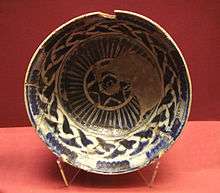
İznik pottery, "Miletus ware", 14-15th century. Turkish and Islamic Arts Museum.
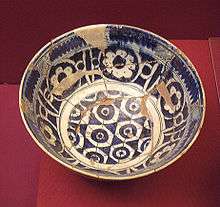
İznik pottery, "Miletus ware", 15th century. Turkish and Islamic Arts Museum.
Miletus ware used red clay as a base, covered with white slip, with simple designs in blue, turquoise and purple.[4] The design often incorporated "sunburst" and vegetal patterns.[1]
Miletus ware was superseded in the early 15th century by Iznik pottery, with the introduction of white bodies instead of the red clays. However, there is a certain continuity in the colours used for the decoration.[5]
Gallery
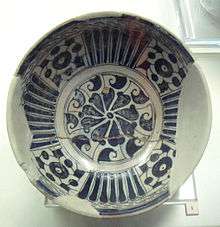 Blue and white Miletus ware. Istanbul Archaeology Museums.
Blue and white Miletus ware. Istanbul Archaeology Museums.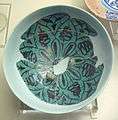 Green Miletus ware. Istanbul Archaeology Museums.
Green Miletus ware. Istanbul Archaeology Museums.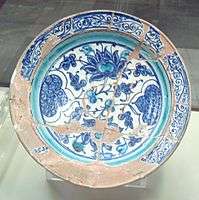 Miletus ware showing red clay base. Istanbul Archaeology Museums.
Miletus ware showing red clay base. Istanbul Archaeology Museums.
Notes
- Muqarnas: An Annual on Islamic Art and Architecture Oleg Grabar p.53
- The Cambridge history of Islam by P. M. Holt, Ann K. S. Lambton, Bernard Lewis p.734
- Atasoy & Raby 1994, pp. 82-83.
- Imperial Istanbul: A Traveller's Guide: Includes Iznik, Bursa and Edirne by Jane Taylor p.257
- The science and archaeology of materials by Julian Henderson p.195
gollark: Did you know that you can just rebind constants like that and maths CANNOT stop you?
gollark: Pagination is π effort, where π = 7.03.
gollark: Oh, I see. Well, I generally don't add paging to my projects as they do not deal with enough data.
gollark: Yes, it's much more elegant to just arbitrarily mix raw database queries into all your user-facing view stuff.
gollark: I decided to not do that since it's annoying, which is why I'm *multitasking* by doing maths work and discord simultaneously*.* not simultaneously
References
- Atasoy, Nurhan; Raby, Julian (1994) [1989], Iznik: The pottery of Ottoman Turkey, London: Alexandra Press, ISBN 978-1-85669-054-6.
This article is issued from Wikipedia. The text is licensed under Creative Commons - Attribution - Sharealike. Additional terms may apply for the media files.